„Grosses Leeres Land“
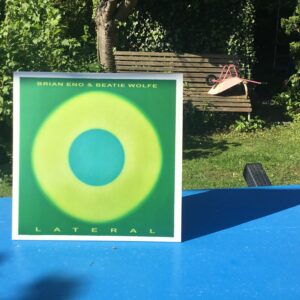
Parallel zu dem Songalbum „Luminal“ von Beatie Wolfe und Brian Eno erscheint am 6. Juni, als LP, CD, und DL, das Instrumentalalbum „Lateral“, mit der Komposition „Big Empty Country“: in der Vinyledituon heisst Seite A „Big Empty Country (Day), und Seite B „Big Empty Country (Night)“. Einmal mehr öffnet dieses Ambientwerk eine ganz eigene Atmosphäre, die zwar unverkennbar Enos Handschrift trägt, aber eben einen weiteren unerhörten Raum öffnet, insofern nur strukturell vergleichbar ist mit Grosskompositionen wie „Discreet Music“, „Thursday Afternoon“, „Lux“, oder „Reflection“. Der Titel „Big Empty Country“ ist mit Bedacht gewählt, und impliziert (mein ganz privater Höreindruck) sowohl das Unheimliche wie das Unberührte, das Pittorekse wie das Postapokalyptische. Der Klang der Gitarre, die hier und da ihre Spuren hinterlässt, ist pure Reminszenz ohne Nostalgie. Mehr wird nicht verraten. (m.e.)Once again, this ambient work opens up a completely unique atmosphere that bears Eno’s unmistakable signature, but opens up another unheard-of space that is only structurally comparable with major compositions such as “Discreet Music”, “Thursday Afternoon”, ‘Lux’ or “Reflection”. The title “Big Empty Country” was chosen with care, and implies (my very private impression) both the uncanny and the untouched, the pittoresque and the post-apocalyptic. The sound of the guitar, which leaves its mark here and there, is pure reminiscence without nostalgia. (m.e.)
„Grosses Leeres Land“, und andere Traummusik

Es ist noch unklar, ob ich meine kommenden Klanghorizonte völlig ohne Interviewausschnitte, als eine Art Essay aufziehe, oder mit drei Interviewpartnern, die Angel Bat Dawid, Beatie Wolfe und Brian Eno wären. Ein kontrastreicheres Gespann lässt sich kaum vorstellen: Die aus ehrwürdigen Free Jazz Zirkeln Chicagos entstammende Angel mit all ihren „african roots“ und der Tendenz, jeden Auftritt in eine wilde Perfromance zu verwandeln, sowie der gewitzte „spirit“ von Beatie und Brian, das hätte was! Ohne Interviews würde – HIER! – eine alternative Playlist aktiv!
Heute Nacht träumte ich, dass Brian bei mir in einem Frankfurter Hotel zu Gast war. Ein offensichtlicher Tagesrest, denn ich beschloss, am kommenden Montag Brian und Beatie ggf. ein paar Fragen zu senden (über DGG / Verve). Nicht so leicht, mich und ohn da ei zu überraschen, zu gut kenne ich mich in Brians Gedankenwelt aus. Und so sassen wir in meinem sehr geräumigen Hotelzimmer, und ich war ein wenig ratlos. Brian hatte mir als Geschenk leuchtende alte Alben unter anderem von David Darling in Form kleiner Kristalle mitgebracht, die ihre Klänge nur preisgaben, wenn man sie in Licht tauchte. Trotz dieses Highlights verlief die Begegnung etwas schleppend.
NEW GHOSTS OF HIGHWAY 20
Nach dem Erwachen ging mir die Musik von „Lateral“ durch die Sinne. Ich hatte am Vortag der einstündigen Instrumentalkomposition gelauscht, nur Beatie an der Gitarre und Brian an den „synths“. „Lateral“ besteht aus acht Teilen „Big Empty Country“. Nüchtern gesagt: wie bei Discreet Music, Neroli, Lux, Thursday Afternoon oder Reflection (HIER mein alter „Manatext“ (oder sollte ich „Metatext“ sagen?) zu dem Album), passiert (scheinbar) nicht viel in diesen sechzig Minuten, aber das, was passiert, kann endlos faszinieren, zum Träumen einladen, immersiv sein, inspirierend, Vordergrund, Hintergrund, Mittelgrund. So umfangreich Brians Katalog der Ambient Music ist, er öffnet mit jedem dieser Album eine andere Soundwelt.
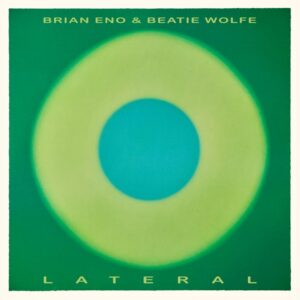
Weniger nüchtern formuliert, und nicht ganz in eigenen Worten: „Big Empty Country: was für ein Trip! Die meisten Reisen führen über eine gewisse Distanz, um ans Ziel zu gelangen, doch nur wenige packen den Ort, an dem man sich befindet, mit solch komplexer, unverschämter Herrlichkeit aus, dass man keinen einzigen Schritt tun muss, um ans Ende des Universums und zurück zu reisen.“
Gönnen Sie sich nun erstmal einen tiefen Atemzug! (eine kurze Pause)
Parallel erscheint am 6. Juni die nicht weniger fesselnde „Country Dream Music“ von „Luminal“ des Duos, mit den Gesängen von Beatie, den „background vocals“ von Brian, sowie allerlei Instrumenten. Wundersam tief und luftig!
WIDE OPEN SPACES
Eins noch: bei dem David Darling-„Kristall“ handelte es sich um „Cello“ mit dem Himmelblau aus einem Godardfilm. Damals, früh in den Neunzigern schickte ich Brian diese ECM-Produktion von Manfred Eicher, und er war begeistert!
Wie auch Tyran Grillo, der zu Cello schrieb: „…one of the most stunning albums ever to be released on ECM in any genre. Its fluid paths feel like home. Darling plows the improvisatory depths of his soul, given free rein in the studio to paint the negative spaces in between those clouds on the album’s cover, ever deeper, ever truer to the core of something alive. Most journeys might take you across some distance to get you to where you’re going, yet few will actually unpack where you are standing with such complex, unabashed glory that one need not take a single step to travel to the end of the universe and back. Cello is one such journey.“
Appendix:
ORANGE JUICE FOR THE EARS: BEATIE AND BRIAN (HERE!)
PLAY ON: ANGEL BAT DAWID IN ACTION (HERE!)in-depth reviews of Lateral (Big Empty Country) and Luminal will be posted at the end of May, in German and English.
The exciting two albums of Mr Henderson from the 70‘s
In meiner Erinnerung wurden die beiden Alben „Horn Culture“ von Sonny Rollins und „Multiple“ von Joe Henderson auf der gleichen Seite in einer alten Ausgabe des Jazzpodiums besprochen. In meiner Erinnerung bekam Sonny die vollen fünf Sterne, und Joe viereinhalb. Bei mit war es damals und ist es heute noch andersrum. Ernst beiseite, „Horn Culture“ ist auch ein tolles Album! Wie „Multiple“ ist auch „Horn Culture“ auf dem Label „Milestone“ erschienen, anno 1973. Bisher noch keine „reissue“! Im übrigen fällt mit auf, dass ich im folgendem Text vergessen habe, meiner Begeisterung über Larry Willis‘ Rhodes-Piano Ausdruck zu verleihen!
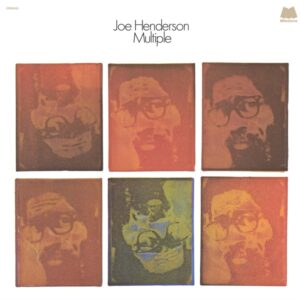
Ich kenne seine Lebensgeschichte nicht, aber es verwundert schon, dass er in den Siebziger Jahren so wenig Musik aufnahm. Ein Werk namens Canyon Lady“ kam mit illustrer Besetzung und all seinen „latin vibes“ nicht an seine zwei „milestones“ aus jenem Jahrzehnt heran. Ich stiess auf ihn fast zufällig, als er schon lange Geschichte geschrieben hatte auf dem Label Blue Note, als Leader und Sideman ein tonangebender Meister des Saxofons, auf etlichen Klassikern.
Dann, als die Zeit der „fusion music“ anbrach, Jazz und Rock und Funk und „weissderkuckuckwasalles“ sich in kühnen Amalgamen fand, vom „elektrischen Miles“ bis „Weather Report“, da tauchte auch Joe Henderson auf. Er dachte sich aber nicht, dass er jetzt mal was Modernes für die Kids machen würde.
Joe suchte sich Produzenten, die das Studio auch als Spielwiese begriffen und nahm zwei Alben auf, die das pure Feuer waren und auch sonst der griechischen Lehre der Elemente tollkühne Klänge folgen liessen: „The Elements“ hiess das eine Werk, das mit erlesener Bande, mit Alice Coltrane, Charlie Haden und Co. Wasser, Erde und Luft folgen liess. So mitreissend und deep wie „Brown Rice“ von Don Cherry oder „Love, Love“ von Julian Priester.
Das andere Album, „Multiple“, umarmte nicht ganz so ferne Horizonte, und war gleichermassen wild, funky, herzergreifend (dieser warme Ton, selbst wenn er die Luft zerriss, in ausgewählten Momenten of „overblowing“! ). Am Bass Dave Holland (vor Tagen noch, the old fire still burning, an der Seite von Anouar Brahem in Hamburg), am Schlagwerk Jack DeJohnette.
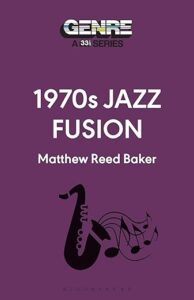
Diese beiden Alben sind in den letzten Jahren als Schallplattem neu aufgelegt worden, „Multiple“ zuletzt, feines Remastering durchweg, und was das Schönste ist: die Musik nimmt mich heute genauso gefangen wie damals in dem Siebzigern, als ich darüber las, im Jazz Podium, und gleich zugriff. Ich kann mich an den beiden Alben offenbar nie satt hören, und verpasse selten einen einzigen Ton seines Spiels!
(Also, wenn das mit dem angefragten Interview mit Eno & Wolfe nicht klappt, und / oder ich eine Woche vor VÖ nur die beiden dann als Videos gelisteten, überall tausendfach gehörten, Songs spielen darf (s. „Ultimative Playlist nebenan in „Radio“), dann hebele ich wohl den zentralen „Beatie & Brian-Part“ aus und spiele „Tress-Cun-Deo-La“. 10 Minuten und 34 Sekunden: das ist so verdammt grossartige Musik! Und die Moderation hätte ich auch schon im Sack.)
„What can ordinary be“ (on a sunny afternoon)
Ich bin viel zu sehr am reinen Hören interessiert, um je ein besonderes Faible für Songvideos entwickelt zu haben, aber dieses ist eine Ausnahme von der Regel, ganz gleich, ob man Song und Bilder werkimmanent deutet oder biographische Fakten hinzuzieht. Als es mir noch vorschwebte, Deutschlehrer zu werden, interessierten mich beispielsweise die diversen Interpretationsverfahren, Herr Gadamer und der „hermeneutische Zirkel“ so sehr wie die Freuden der Konkrete Poesie (ich belegte Proseminare zu beiden Themen, und sehe noch heute Ernst Jandls „Laut und Luise“ auf meinem Nachttisch in Münster liegen, neben einer alten Tonbandmaschine mit vielen Leonard Cohen-Liedern und einer Sendung von Winfrid Trenkler über Soft Machine).
Auf jeden Fall ist Robert Forsters „Butterflies“, geschrieben mit ohne seine Lebensgefährtin Karin Bäumler, und dargeboten „at home“ mit Karin und einer aufmerksamen Katze im Garten (oh, Fusel klopft gerade ans Fenster und will eine kurze Sommerpause einlegen), ein Meisterstück, was filmische Inszenierung, Song und Lyrics betrifft. Mir erscheint es auch alles andere als weit hergeholt, hier eine Spur Ray Davies zu wittern (so wie mir bei einem Song von Alabaster DePlumes neuem Werk Schwingungen einer Platte von Donovan in den Sinn kommen namens „Wear Your Love Like Heaven“).
Einmal, als die beiden Go-Betweens mir gegenüber sassen, erzählte ich ihnen, wie ich ihr allerwrstes Album im Nördlichen Bayerischen Wald hörte, mit dem langen Song als Favoriten, und dass es nur ein Katzensprung von Grasfilzing nach Regensburg war, früh in den Achtzigern. Ich nannte „understatement and passion“ die „basics“ in ihrem Songbuch. So viele Jahre später jetzt. Hier, in diesem Song ist das wieder so eine spezielle Mischung: unendliche Nonchalance auf der einen Seite, das Dunkle, Unheimliche schimmert auf der anderen durch, genauso wie eine weiter zurückliegende magische Zeit: man kann es werkimmanent betrachten, Biografien als Folien drüberlegen. Selbst Lee und Nancy würden staunen und einen Sommerwein entkorken.
(m.e.)
News From Frederiksberg Records

Das Besondere dieses beinah vergessenen Albums aus dem Jahre 1983, das schon seinerzeit nur privat in kleiner Auflage gepresst und vertrieben wurde, ist keinesfalls eine unerhöre Mischung von Stilen. Zuviel ist hier vertraut als Anklang von Bill Evans bis MCoy Tyner, und das Quantum Kalimba reicht nicht aus, um der Zeit von damals voraus zu sein. Alle vier Jungs kannten ihren Coltrane, besonders die Quartett-Alben, und hin und weg waren sie nach eigenen Angaben von John Handys „Indo-Jazz“ namens „Karuna Supreme“, einer herrlichen Schwarzwald-Produktion des Labels MPS. Das Besondere ist gar nicht leicht auf den Punkt zu bringen, und beruht auf der immensen Spielfreude, die nie überdreht und stets massvoll bleibt, mit einer frappierenden Leichtigkeit des Ausdrucks. Ich hätte damals meine helle Freude gehabt, diesen gesammelten Unaufgeregtheiten zu folgen, und hole das nun gerne nach, dank einer weiteren Ausgrabung der Schatzjäger von Frederiksberg Records: „Abendmusiken“ von „Green Cosmos“. Die Aufnahme ist vom Feinsten, und dass die Jungs hier alles, was sie kennen, in die Stücke hineinlegen, und etwas von dem, was sie nicht kennen, bringt ein Gespür fürs Unerhörte ins Eigentlich-Vertraute!In memory of …
Later in his life, John Kelman wrote a stream of reviews about albums that did not get a fresh remaster or that just appeared in the endless stream of novelties. He had an eye on albums that he kept returning too every once in a while and nearly vanished from the public eye and ear.
One of these albums that just springs to mind, was „New Rags“ from Jack DeJohnette‘s Directions. A rather wild ECM production, full of energy and „uninhibited joie de vivre“. I bought that album in the days it was released, and was impressed when listening again, after reading John‘s text: I joined his excitement.
Now I remember our conversation about „Manafon Variations“ in Kristiansand, a sort of „remix-reshape-reinvention“ of the meanwhile classic „Manafon“. We talked about the richness of details, the impressing input of artists that were not around in the days of Manafon, and, especially David‘s „slow motion singing“. O me oh my!
This conversation on a rainy afternoon has happened a long time ago, and moments of it appeared out of nowwhere today when I put on the first vinyl reissue of „Died In The Wool – Manafon Variations“. The double album features an extra sidelong track „When we return, you won‘t recognise us“ that is so much more than a curiosity from dusted shelves.
Now, we old listeners do exactly return, and we experience every piece of it like it would be a terrific first time. This work is on par with Manafon, equally powerful. One of the side effects I experienced was, well, an uninhibited „joie de écouter“, a strangely elevating feel in a work that is generally supposed to come from the dark. A passionate affair all the way through!
In the words of John from 2011: „If Manafon was a masterpiece that found new ways to shape music, then Died In The Wool is equally important, as it eschews the concept of remix and, in its place, aims for reinvention—re-composition that takes place, in multiple degrees of separation, from the founding material that was the previous album’s inspiration.“
Für Scotch und Candlelight auf El Hierro und sonstwo
Vorspiel mit einem alten Text: Der vertraute Klang eines Cocktailshakers voller Eis und entfernter Möwen weichen einer einfachen Melodie, einem im Licht sich räkelnden Rhythmus. Wir befinden uns auf einer Zeitreise in ein Japan, das bald eine halbe Ewigkeit zurückliegt. Die Siebziger Jahre des 20. Jahrhunderts, jene tollkühne Dekade. Wir träumten damals vom Fujiama, der uns auf grossen Briefmarken entgegenblickte, verspielt und majästetisch, als wir baby boomer waren. Japaner träumten anders. Und so befinden wir uns gerade mitten in einer Musik, die deren ausgesuchte Urlaubsparadiese zu damaligen Wirtschaftsblütezeiten heraufbeschwörte. Die südlichen Inseln im Pazifik.
„Pacific“ ist der Titel dieser Langspielplatte. Das Werk entstand 1978. fast alles instrumental, bis auf die eine Zeile, die mit dem „Sommer in ihrem Haar“ alle Träumerei auf den Punkt bringt. Die drei Pazifikforscher: Shugeru Suzuki, Harry Hosono, der bald das Yellow Magic Orchestra mitgründen sollte, und der Dritte, einer der Cracks der japanischen City Pop-Szene, Tatsuro Yamashita. Wir erkennen einen alten Bekannten, der auf dem Album auch mitmischte, Ryuichi Sakamoto. So jung, man glaubt es kaum. Eine Prise früher Synth-Pop, die japanische Variante amerikanischer Exotikträume a la Les Baxter, melodische Funkrhythmen, ein schwebender Horizontöffner, eine Brise New Age, easy peasy, soft and breezy.
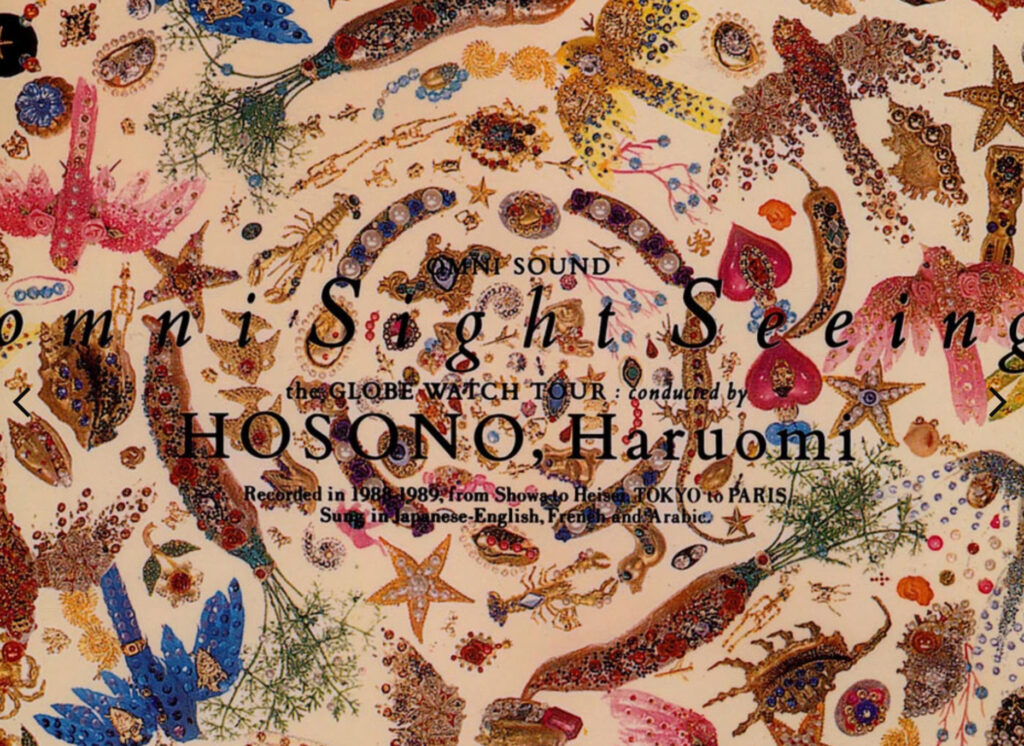
Ein gutes Jahrzehnt später. “I follow the peacocks as they sing like wo la la la”. Das Album: OMNI SIGHT SEEING. Anno 1989. . In den Achtzigern war „Weltmusik“ angesagt, aber vieles von diesen globalen Sounds hielt eine geschmäcklerische Sanftheit parat, mal virtuos, mal berechnend, und oft genug war das vollmundige „CROSSOVER“ einfach langweilig wie effekthascherisch.Wenig kam heran an die rohe Wucht und Durchschlagskraft von „My Life In The Bush Of Ghosts“ von Eno und Byrne, an die surreale Magie von Jon Hassell und den drei Codona-Alben auf ECM. Einiges wohl, aber vieles nicht. Und da taucht nun, als Reissue bei Victory Records, diese Platte auf, die diesen Globetrotter-Modus auch noch auf das Cover setzt, als Untertitel in schwarzen Lettern: „recorded in 1988 – 1989 from Showa to Heisen, Tokyo to Paris, Sung in Japanese-English, French and Arabic“. Und was darüber steht, wirkt wie eine touristische Animation: „omni Sight Seeing / the GLOBE WATCH TOUR: conducted by Hosoni Haruomi“. So weit, so gewöhnungsbedürftig.
(Die Fortsetzung mit „der psychoakustischen Erfahrung“ folgt in Kürze, die Platte kann man für erstaunliche 20,99 Euro bei HHV bestellen, Ingo könnte vorbeigehen in dem Berliner Laden und das Porto für die Lieferung einsparen (bei Amazon kostet das Vinyl einer anderen Ausgabe 338 Euro – und so viel vorab, ich gebe der Platte 4 von 5 Sternen und empfehle sie uneingeschränkt, Jan R. wird sie auf Tidal hören, wie er mir mailte. Das white marbled vinyl eine Augenweide.)
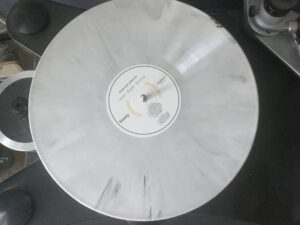
Ich besorgte mir das Album, weil ich Haruomis „Pacific“ vor Jahren als Entdeckung empfand, und einmal mehr überzeugt mich auch dieses Werk von Anfang bis Ende, warum, genau, kann ich aber kaum sagen. Es geht ja auf der Rückseite des Albums, im Kleingedruckten, noch weiter, und wenn man da von „Astralreisen“ liest und „spiritueller Reise“, noch dazu in recht plakativer Sprache, fragt man sich, ob der Gute zuviel Kaffee im Nirvana getrunken hat, ein romantischer Schwärmer ist, oder reale Grenzerfahrungen in Klänge übersetzt.
Denn dieses Album ist ein Tollhaus von kreuz und quer purzelnden Einfällen (das Cover passt da schon wunderbar!). hosono Haruomi in einem Samdkasten aus Alphaville. In eine japanische Technovariante mit Härte 8 schmuggelt er Bandoneonistas hinein, marokkanische Herzensgesänge, ein fröhlich aisflippendes Saxofon, um danach in einem wundersam floatenden Ambient Track jeder zerfliessenden Sekunde gewisse underwater vibes unzerzumischen – call it „balearic“! Schön verrückt und erfinderisch seine elektronisch unterfütterte Version von Duke Elllingtons „Caravan“! Alles kommt mit einem ausgeprägten Spieltrieb daher, und könnte leicht als nette multikulturelle Petitesse durchgehen, aber es fesselt mich, sorgt für Heiterkeit, Wundern und schöne Verblüffung. Seltsam.
Skrifum
Let’s call this, like that underrated gem of Leonard Cohen, another „new skin for the old ceremony“. Jon Balke’s fourth solo piano album on ECM is a strangely organic affair, no matter how much science from the laboratory may be involved. A llittle machine called „spektrafon“ is extrapolating sounds from the grand piano that inspire in subtle ways Jon‘s playing of the keys. I‘m immediately thrilled by the game he‘s playing here. Like from a shadow world, sounds unheard appear in drone-like clothing, on the verge of vanishing or lingering on – you never know. And they are not tapping into the „drone trap“ by sounding especially mysterious or alien. So forget about „new age“ and „old tricks“. Thanks to Jon’s heightened awareness ranging (to follow the meaning of the Icelandic word „Skrifum“) from a sharp pencil to a broad brush (staying away from conversational stylings), every track of this adventurously discreet music is a little world of its own. The whole album is a quietly flowing, exciting journey, a ghost story for an old instrument – delivered with a constant sense of wonder. Welcome to your next favourite ritual of deep listening!
(m.e.)
More Praise for it in KLANGHORIZONTE
DEUTSCHLANDFUNK
27. März 2025
21.05 Uhr
Richard Dawsons „Endspiele“
„Nach The Ruby Cord, einem 80-Minuten-Album, das in einer halluzinatorischen VR-Zukunft spielt, konzentriert sich Richard Dawson hier auf kleinere Dinge: nämlich auf das alltägliche Trauma von Familien am unteren Ende der Mittelschicht. Dennoch ist sein Songwriting so kraftvoll und bewegend wie eh und je, mit all den düster-komischen Anklängen, für die er bekannt ist. Auch musikalisch ist End Of The Middle zurückgenommen, in seiner Sparsamkeit vom frühen Neil Young inspiriert, mit markanten Free-Jazz-Holzbläsern, die Dawsons romanhafte Erzählungen beleuchten. „Gondola“, ‚Bullies‘ und ‚Removals Van‘ deuten ganze Welten an, bevor ‚More Than Real‘ in tränenreichem Technicolor schließt.“
So die kleine Besprechung von Tom Pinnock in der Februarausgabe von UNCUT. Einige von uns kennen diesen Song-Exzentriker seit Jahren, jetzt legt er einen Songzyklus vor, der in anderer Weise als Wim Wenders‘ „Perfect Days“ von dem japanischen Regisseur Ozu inspiriert ist. Ich wittere hier auch mehr als einen „touch of Beckett“ und erinnere mich, wie wir bei unserm Englischlehrer einst Becketts „Endspiel“ lasen und interpretierten!
Ich habe das Album bereits hören können – ein Songvideo („Polytunnel“) habe ich in meinem „Echo“ auf Enos Songseminar verlinkt. Dass die lyrics kleine Welten kreieren, in einer dem „normalen Alltag“ entnommenen Sprache, die durch ihre Kombination mit überraschenden Wendungen eine besondere Kraft entfaltet, ist ein wirklich gekungener Kunstgriff von „songwriting“. In comment 1 die lyrics des Liedes „Gondola“. Dieses Lied, in dem eine frei flottierendes Klarinette wundersam herumgeistert, endet mit folgender Strophe – und einer etwas anderen Venedig-Impression!
Meine Träume starben wie Delphine in einem Netz.
Ich konnte nie nach Venedig fahren
und wie viele Sommer habe ich noch vor mir?
Ich kann immer noch nicht glauben, dass ich eine Oma bin.
Jen hat gerade ihre Fahrprüfung bestanden.
Ich werde ein paar tausend Pfund
in ein Auto investieren
und mit ihr in den Urlaub fahren –
„making memories“, bevor es zu spät ist.
Da sind wir nun, unter der Rialto-Brücke,
zusammengekauert in einer Gondel.Ich möchte HIER noch einen weiteren Song aus „End Of The Middle“ vorstellen. Am besten nicht einfach kurz reinhören, und schnell entscheiden, sondern vielleicht erst mal die lyrics im Vorfeld lesen (das Original, und eine rasche Deepl Übersetzung folgt in Kürze in Comment 2), und dann den Song in Ruhe aufnehmen. Richard Dawson gehört zu den interessantesten „Leftfield“-Songschreibern Englands, ein sympathischer Coldplayfan wird rasch die Flucht ergreifen, und auch mit der Stimme müssen sich (man muss natürlich gar nichts) manche ggf. erstmal anfreunden. Dann aber könnte – ich sage „könnte“ Dauerhaftes entstehen.
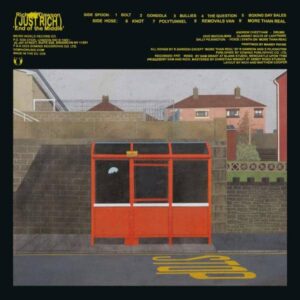
Es ist schon toll, was Domino seit Jahr und Tag publiziert (zuletzt das editorische Mammutmeisterstück „G stands for Go-Betweens, Vol. 3“, ein Boxset, der schneller ausverkauft als besprochen wurde), auch Robert Wyatt (in manchem ein Seelenverwandter von Robert Wyatt) hatte da in seiner letzten Schaffensphase eine Hafen gefunden. Und von wem stammte das Album des Jahres 2024 in den Ohren von drei, vier Flowworkern?! Bingo! Und sonst, anno 24: John Cale, Julia Holter, Jon Hopkins, Hayden Thorpe, Bonny Prince Billie (bald eine neue Scheibe) und und und…. Nochmal zurück zu Richard Dawson am 14. Februar erscheinendem Album, das auch eine Brücke schlägt zu Michael Leighs Filmen, zu den alten Erzählungen von Alan Sillitoe – wer erinnert sich noch (auch eine Verfilmung gab es) an „The Lonliness of The Long-Distance Runner“. In den Worten von Richard: . “It zooms in quite close-up to try and explore a typical middle class English family home,” Dawson said in a statement. “We’re listening to the stories of people from three or four generations of perhaps the same family. But really, it’s about how we break certain cycles. I think the family is a useful metaphor to examine how things are passed on generationally.”Die letzte Endeckung des Jahres
Tommy Perman und Andrew Wasylyk made a wonderful album on Clay Pipe Music, and they will be my first interview partners in 2025. „Ash Grey And The Gull Glides On“ will be, simply said, a revelation for all friends of Cluster, Moebius & Roedelius with or without Eno, Boards of Canada, the moody side of experimental electronica, though it sounds different from all names mentioned, and never strolls along well troden paths. You can easily fall for this album full of surprises and sidesteps – the old playbook doesn‘t work here. A little wonder.
Einer schreibt, und so launig versuchen manche Kritiker zu umschreiben, was sie hören, mit Stichwörtern und Vergleichen, die allesamt ein wenig hinken und treffen zugleich. „Das eröffnende, gedämpfte, flatternde Climb Like A Floating Vapour beginnt fast wie Dub-Techno, bevor Saxophon und Klavier es in etwas verwandeln, das an eine moderne Soft Machine erinnert.“ Oder : „“Remain In Memory“Full Of Light ist ein sehr cooler Kontrabass-Groove. Das Stück, das sich um mehrere Mantras – „Hand zu Hand, Herz zu Herz“ – gruppiert, bewegt sich in einem Bereich zwischen den US-Post-Rockern Tortoise / Isotope 217 und Sun Ra’s Twin Stars Of Thence“. „Ash Grey And The Gull Glides On“ ist im Nachhinein bei meinen zwanzig Lieblingsalben des Jahres gelandet.